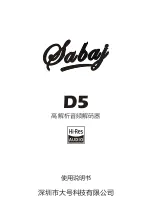
47
Program
8. Decoder Settings (Programming)
Chapter 8 is dedicated to changing the settings of the locomotive sound
decoder. Unless you are familiar with the handling of CVs please take the time to
read these occasionally quite complex instructions.
After an introduction to the world of parameters in chapter 8.1, we explained in
Section 8.2 how to change various parameters in DCC and Märklin® centers.
The chapter section 9 to 17 illustrate, which parameters influence the behavior of
the LokSound decoder.
8.1. Variable decoder features
Some features of a LokSound decoder such as the number of the function
outputs or the maximum current carrying capacity of the motor output are
physically fixed by the hardware and can not be changed. Nevertheless, there
are all sorts of options, the behavior of the LokSound decoder by comparison
change software-governed properties to influence. there are one or more
memory locations where numbers or letters can be stored within the decoder for
each adjustable parameter.
You can think of the individual memory locations as "tabs" that are stored in a
large file box so that the individual cards can be found again, these have a
number or marking with the property of the card, such as "loco" or "speed". Now,
if you continue to imagine that these cards can be written with a pencil; Changes
are therefore "erase and rewrite" by any time. Not all "cards" can be described:
Some of information ones as the manufacturer's code are hard coded. The
contents of the memory locations can be determined by you, then, and is read
by the decoder during operation and take account Untitled. A procedure that is
known as "programming"
8.1.1. M4 configuration area
has the above-described CV concept of NMRA some disadvantages le: On the
one dealing with the collection CVs as CV29 is complicated due to the binary
representation, on the other hand numerical value can be entered only one (!).
How can you save with DA locomotive name?
There is no way for a center, zufinden challenges which CVs a decoder
supports. The NMRA has "forgotten" to define a mechanism by which the
decoder a control center can tell which properties it supports.
When introducing mfx® wanted to save the user the handling of CVs, values and
binary system. Rather, the Panel should "consult" the appropriate decoder to the
possible properties, only to simplify the entry of values thanks to a graphical user
interface.
At one mfx® capable central They therefore do not contribute, for example, CV 3
the value 15, but put the "acceleration time" to 10 seconds. Thanks mfx® you no
longer remember that CV 3 contains the acceleration time and the value of 15 is
equivalent to about 10 seconds. All these complex technique hides the mfx®
center in front of you. Therefore, the decoder has at mfx® no direct input to the
internal memory location, area called mfx® configuration is provided. Allowed is
usually only indirect access via the user interface of the control panel. This
procedure has only one problem: How can access zer other non-mfx® capable
centers on the configura- tion area Besit-? Access used to be originally a register
concept that was the NMRA DCC CVs. Here, however, not all properties of
using mfx® were unfortunately reached. Moreover, it was not developed mfx® in
the originally envisaged senses and "remains" largely due to the state of the
decoder from 2004. At least since the ESU Central Station ® 60212 with the
"Re-
Summary of Contents for 58315
Page 104: ...104 notes...
Page 105: ...105 notes...
Page 109: ...109 notes...
Page 110: ...110 notes...
Page 111: ...111...
















































